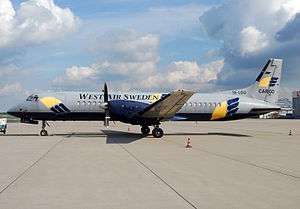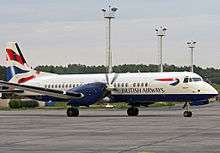British Aerospace ATP
| ATP | |
|---|---|
 | |
| West Air Sweden ATP | |
| Role | Airliner |
| Manufacturer | British Aerospace |
| First flight | 6 August 1986 |
| Introduction | 1988 |
| Produced | 1988–1996 |
| Number built | 64 |
| Developed from | Hawker Siddeley HS 748 |
The British Aerospace ATP (Advanced Turbo-Prop) was an airliner produced by British Aerospace, introduced in the 1980s as an evolution of the Hawker Siddeley HS 748. The fuel crisis and increasing worries about aircraft noise led business planners at British Aerospace to believe that there was a market for a short-range, low-noise, fuel-efficient turboprop aircraft. By the time it entered the market, the segment was already well represented by designs such as the de Havilland Canada Dash 8 and ATR 42, and production was ended after only 64 examples.
Design and development
The airframe of the HS 748 was redesigned with a lengthened 26.01 metres (85.3 ft) fuselage and a 30.62 metres (100.5 ft) wing span. Minor modifications were made to the nose and tail shapes; and smaller windows on a shorter pitch than the 748's were used. The 748's twin Rolls-Royce Dart engines were replaced with Pratt & Whitney Canada PW126 fuel efficient engines. A custom-designed, slow-turning, six-blade propeller was developed by Hamilton Standard.
The aircraft first flew in August 1986 and entered service with British Midland in 1988. The type has an advanced electronic flight instrument system flight deck, and has a good short-field performance. In addition to these virtues, it is also very quiet upon take off. The only U.S. operator of the ATP in scheduled passenger service was Air Wisconsin flying as United Express on behalf of United Airlines via a code sharing agreement.
In total 64 aircraft were assembled at BAe's Woodford and Prestwick facilities with the manufacture of the airframe and wings undertaken at Chadderton. Production ended at Prestwick in 1996. The ATP can accommodate between 64 and 72 passengers depending on the seat configuration.
In 2001 the ATP Freighter project allowed six ATPs to be converted into cargo aircraft for West Air Sweden. Using a modification of the HS 748 freight door, the ATPF can carry 30% more cargo than its predecessor with a 10% increase in running costs. The ATPF made its first flight from West Air Sweden's facility in Lidköping on 10 July 2002.

As of November 2011 a total of 40 ATP aircraft remain in airline service with West Air Sweden (12), Atlantic Airlines (12), NextJet Sweden (4), Deraya (2) and Air Go Airlines (1). The only airline operating passenger flights with the ATP is NextJet Sweden.[1]
Variants
Several ATP variants were proposed and produced for civil and military use:
- Jetstream 61
The British Aerospace Jetstream 61 was an improved derivative of the ATP. It featured an interior based on the Jetstream 41 with innovative cabin wall armrests and an increase in capacity from 64 to 70 seats. In addition the airframe incorporated more powerful PW127 engines and increased weights and range.
The first flight was completed by the original prototype ATP (serial number 2001) reregistered G-PLXI (LXI being the Roman numeral for 61) on 10 May 1994. Four airframes were subsequently produced as Jetstream 61s before British Aerospace’s regional airliner manufacturing operations were merged with ATR on 26 January 1995. With the already highly successful ATR 72 now part of the same product range the Jetstream 61 was immediately cancelled with all four airframes being scrapped at Woodford.
The original ATP and Jetstream 61 prototype is currently in storage at Woodford awaiting a final move to the Jetstream Club at Liverpool.
- Maritime ATP
This was a variant for use in military naval operations, with a surveillance radar under the forward fuselage, nose-mounted FLIR and internal sonar buoys. A suite of special crew stations also featured, as did a choice of up to six weapon pylons under the wings and fuselage. The Maritime ATP was later known as the BAe P.132. None were built.
- ATP-AEW
The AEW was a 1986 proposal for an Airborne Early Warning aircraft for Australia, with two EMI Skymaster radars in nose and tail radomes, similar in appearance to the Nimrod AEW.3. None were built.
Operators

Current operators
- Nextjet
- West Air Europe – Luxembourg
- West Air Europe – Sweden
- West Atlantic – cargo airlines
- Deraya Air Taxi
Former operators
%2C_Belfast_International%2C_May_1994_(02).jpg)
- Air Wisconsin (operating as United Express)
- Asian Spirit
- Biman Bangladesh Airlines[2]
- British Airways
- British Midland
- British World Airlines
- Loganair
- Manx Airlines
- Merpati
- SATA Air Açores
- Sun Air of Scandinavia
- Aireuropa Express
- United Express (operated by Air Wisconsin)
- Deraya
Notable accidents and incidents
- On 19 April 1997 Merpati Nusantara Airlines Flight 106 lost control at 2000 feet on approach to Tanjung Pandan-Bulutumbang Airport in Indonesia. 15 people died and 43 survived the crash of Flight 106 the second worst air accident involving British Aerospace ATP aircraft.
- On 11 December 1999 SATA Air Açores Flight 530 crashed into mountain on the Sao Jorge Island, Açores, Portugal on a short haul flight. All 35 passengers and crew on board died in the crash. The accident was the worst air accident involving British Aerospace ATP.
Specifications
Data from Jane's All the World's Aircraft, 1988–1989[3]
General characteristics
- Crew: Four (Two flight crew + two flight attendants)
- Capacity: 64 passengers
- Length: 26.00 m (85 ft 4 in)
- Wingspan: 30.63 m (100 ft 6 in)
- Height: 7.14 m (23 ft 5 in)
- Wing area: 78.3 m² (843 ft²)
- Empty weight: 13,595 kg (29,970 lb)
- Max. takeoff weight: 22,930 kg (50,550 lb)
- Powerplant: 2 × Pratt & Whitney Canada PW126 turboprop, 1,978 kW (2,653 hp) each
Performance
- Cruise speed: 496 km/h (268 knots, 308 mph)
- Range: 1,825 km (985 nmi, 1,134 mi)
- Service ceiling: 7,600 m (25,000 ft)
See also
- Related development
- Aircraft of comparable role, configuration and era
- Related lists
References
| Wikimedia Commons has media related to BAe ATP. |
- ↑ "British-Aerospace BAe-ATP Production List".
- ↑ "Biman Bangladesh introduces ATP". Flight International. 138 (4244). 4 December 1990. ISSN 0015-3710. Archived from the original on 26 October 2013.
- ↑ Taylor, JWR (Editor) (1988). Jane's All the World's Aircraft, 1988–1989. Jane's Information Group. ISBN 0-7106-0867-5.